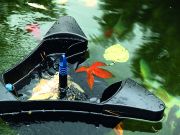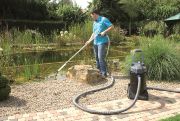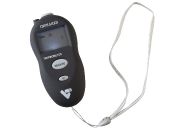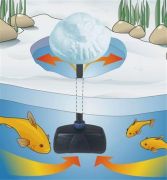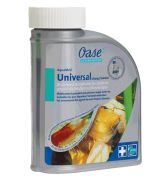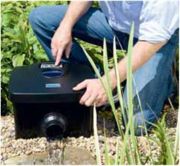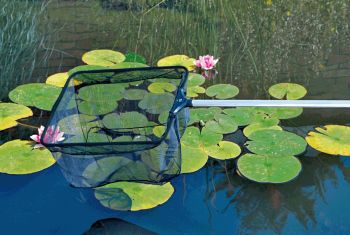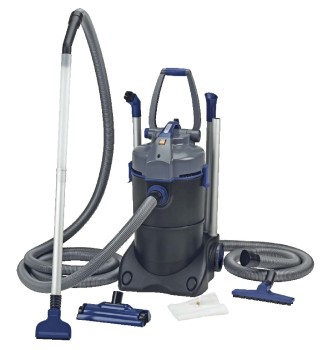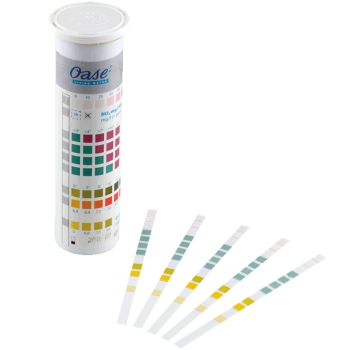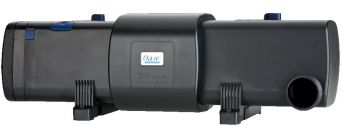Autumn Pond Care Tips
Autumn is the ideal time to clean your pond as the fish are still in prime condition from summer, but the slightly cooler water temperature of early autumn will reduce their stress levels, making them less prone to disease and infection. It is recommended that you do not feed your fish for a couple of days before and after cleaning, as this will reduce the excess waste to remove and will allow the pond and fish to settle after cleaning.
Water testing.
It is good practice to monitor your water quality regularly at this time of year with a Water Test Kit, as the pH value of your pond water may vary.
If you are registering excess nitrates (50ppm +), you should perform a series of small water changes over a period of a few weeks to dilute this pollutant.
After each water change, it's a good idea to introduce a dose of Starter Bacteria into the water. This will assist in regenerating aerobic bacteria within the filter media.
Debris removal.
It is important during the Autumn to ensure that falling leaves are not allowed to enter the pond. This is because any leaves settling on the pond floor will decompose. This process will absorb oxygen and produce toxic gasses. This will have a negative affect on the water quality and aesthetic look of the pond.
Falling leaves can be prevented from entering the pond by installing a Pond Cover Net across the entire surface area of your pond, or prevented from being able to settle by operating a floating Pond Skimmer to collect the leaves from the surface of the pond, before they have a chance to sink to the bottom.
Anything that does make it to the bottom of the pond must be removed before it has time to start degrading. This task can be completed easily with the use of a good quality Pond Vacuum Cleaner.
At this time of year, your marginal plants may start to die off. These dying plants should be pruned and removed as soon as this process begins, as if they are left, they will sink to the pond floor and begin to decompose. This can be performed with the use of a Pond Maintenance Set, whilst living marginal and pondside plants should be covered with polythene or an insulating horticultural fleece to give them some protection from the harsh winter ahead.
Fish feeding.
It is around this time of year that the fish will require a less protein-based feed, as they will by now have stored enough energy from their protein rich summer diet, to allow them to survive the winter on these reserves.
Your water temperature can be monitored using a Pond Thermometer. When the water temperature is consistently registering at under 12ºc, it is time to introduce a more fibre-based diet such as a winter wheat germ food.
The reason for this is that with lower water temperatures, fish do not require a protein rich diet, as their metabolism will begin to slow down and they will have built up a fat reserve to get them through the winter. An Automatic Fish Feeder is beneficial at this time, as it will allow you to automatically regulate the amount of feed going into the pond.
Frozen pond prevention.
It is important that you do not allow the surface of your pond to completely freeze over, as this will prevent oxygen from entering the pond through diffusion, and will also prevent toxic gasses from escaping.
In order for vital Oxygen to enter the water, and harmful gasses to escape, access to surface water is essential. An Ice Preventer can be installed in this situation to keep an area of the pond surface free of ice to enable these vital processes to occur.
Ice Preventers are far more energy efficient compared with pond heaters as they rely on localised water circulation rather than heating the surrounding water (the OASE IceFree consumes a meagre 5 watts, compared to pond heaters which are often 150-600 watts) .
Preventative medication.
Autumn is the ideal time to medicate your pond with a disease-preventitive water treatment.
This will be particularly important come the spring as parasites and pathogens, like fish, will lay practically dormant during the winter and attack fish during the spring when their immune system is weaker.
However, if a treatment is performed in the Autumn, the pathogens will be unable to regenerate rapidly due to the colder water, making life easier for fish come the springtime.
Winterising the pond filter system.
When the water temperature drops consistently under 10ºc, you can start to think about switching off your Ultraviolet Clarifier. This is because the water temperature is now too cold for single celled algae to survive in.
We recommend keeping the filter pump running but elevate the pump from the base of the pond around 30-60cm during colder periods. This will allow the fish to rest at the base of the pond where the water is fractionally warmer, whilst the pump and filter helps to circulate and oxygenate the water in the shallow zone.
If you intend to switch off your filter pump and Ultraviolet Clarifier, you should remove it from the filter unit and store it in a frost free environment. This will prevent any water that may be trapped inside from freezing and damaging the UV Clarifier's delicate quartz glass sleeve.
If you need any assistance or advice regarding pond maintenance, please feel free to contact Water Garden via email or call on 02392 373735. We'll be happy to help.


